Name of game, creator, platform:
I played Gorogoa on an iPad. This is a game created by Jason Roberts.
Target Audience:
Players who enjoy puzzle games, especially those who prefer puzzle games that have a strong and rich narrative. Players who enjoy games with beautiful and/or hand-drawn art.
Important Formal Elements of the game:
Players: 1 player in a player-vs-game format.
Objectives: Solve all puzzles in the game to help the main character obtain all 5 color orbs.
Rules / Procedures: Puzzles are presented as “scenes” that player needs to explore. Player solves puzzles by exploring the scene (through moving across or “into” the scene by tapping on an object to focus on), and moving objects or parts of the scene between the 4 panels. The main character, as well as some objects, can move between the panels, if certain conditions are met (the panels lining up perfectly, for example). The puzzles proceed linearly, based on the narrative.
Boundaries: All game actions happen within the 4 panels that make up the main screen, but part of solving some of the puzzle is pushing the literal boundaries. Each puzzle serves to expand on the game’s boundaries or reiterate it. For example, a mechanic that players learn early in the game is that a panel with a door frame can be “split” into 2. The frame of the door can then be put on another door in different panel, and if a character is in front of this latter door, they can move through the door to the other panel.
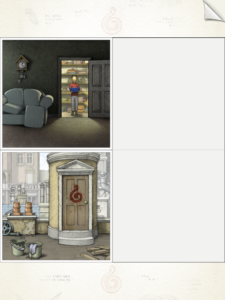
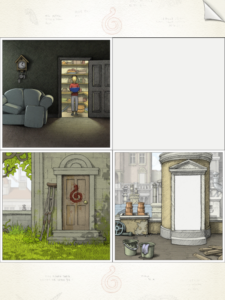
(a mechanic players learn early in game is that panels can be split up — the bottom left panel on the left screenshot is split up into the “frame” and the “door” on the right screenshot.)
Type of fun game intended, and if it met its goals:
Gorogoa intends for fun as Challenge, and it delivers. Each puzzle makes use of the panel-manipulation mechanic in a new way so the player continues to be challenged throughout the game. However, the difficulty curve is carefully managed so that the challenges doesn’t feel overwhelming for players. For example, in the first chapter, the solutions to most puzzle mainly involve moving around within a panel and splitting panels in two and moving the frame to another panel to connect them. These simple mechanics are continuously pushed in future chapters. For example, in the second chapter, players learn that some of their manipulations can have a physical effect on the world (beyond moving the main character). They are shown a shelf that is leaning left, and they know they have to make it lean right to get the lamp to fall towards the character. To solve this puzzle, the player has to find out that the “splitting frame” mechanic that they’ve learned also work for things like “labels” of boxes. They can combine this mechanic with using other panels with objects of varying weights (such as rocks and cotton balls) to change the weight distribution on the shelf and make it lean right.
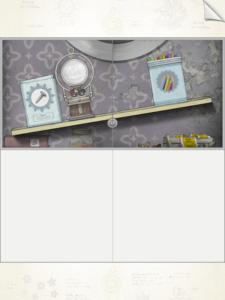
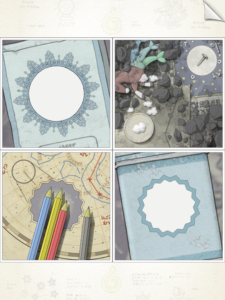
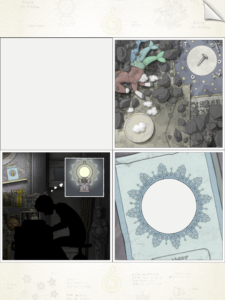
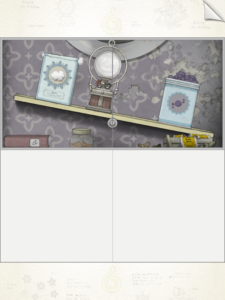
(The weight puzzle, from left to right, top to bottom. 1: player faces a shelf leaning left. They need to get the shelf to lean right, to make the light fall down. 2: player can zoom into each of the box and use the frame-splitting mechanism that they’ve learned. 3: they then make use of the scene that was split from the nail box, which contains some cotton balls, to “place” the cotton balls inside the box by putting the frame with the box (bottom right) on top of the cotton ball (zoomed in, top right). They do the same thing to place some rocks inside the other box. 4: due to the weight difference, the shelf now leans to the right!)
The process of exploring and pushing the boundaries of the game creates fun as Discovery. One notable rule of the game that supports this is how the game doesn’t have a “reset” button, because none of the puzzles require players to remember its initial state. The puzzles are designed to reward exploration, because solution to a new puzzle is often a part of the scene / a mechanic that the player has not discovered. For example, for one puzzle, player need to notice the positions of the panels relative to each other. They have to place the panel with a magnetic needle on opposite corners with the north star on a globe, to turn the needle to the correct position for the next step of the puzzle.
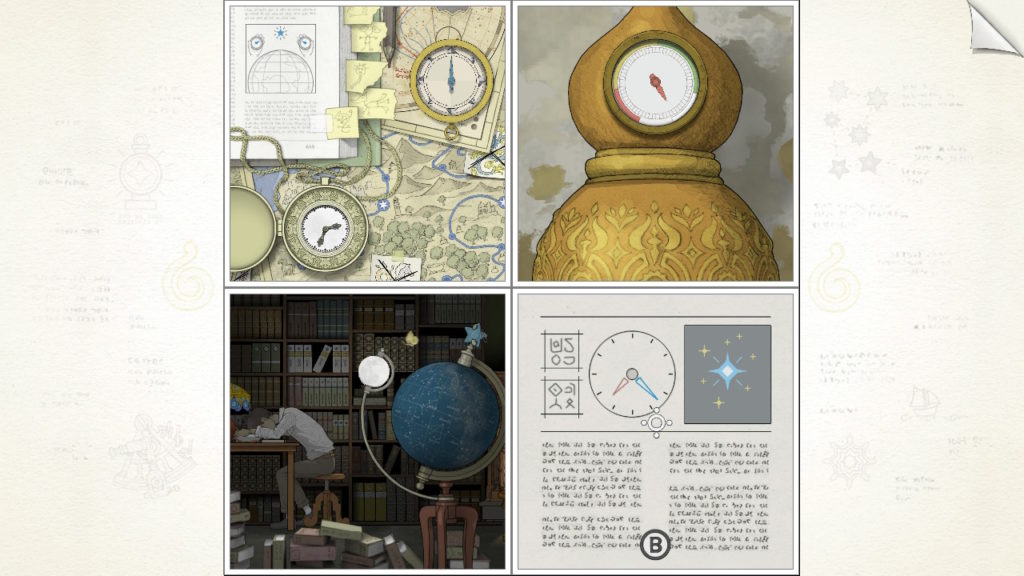
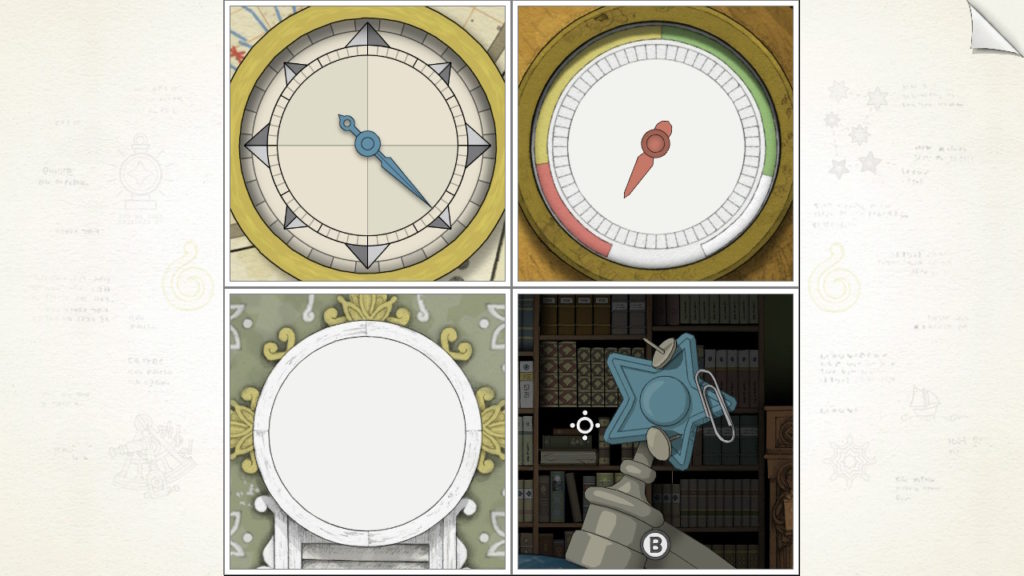
(top: the puzzle with the hint on the bottom right panel, that the blue needle should point in that direction. bottom: solving the puzzle requires zooming into the north star on the globe and the blue needle, and positioning them relatively as such)
Moments of particular success or epic fails:
Particular success:
- One of our readings advises that “to make a great puzzle, first make a great toy.” The controls of Gorogoa (picking up and moving panels, zooming in, etc.) feel very smooth and intuitive to the game’s presentation as a hand-drawn 4-panel scene. The intuitive control also aids the game in delivering fun as Discovery because it makes player exploration feel very natural.
- The embedded narrative helps to structure the puzzles — for example, at the beginning of the game, we see the main character reading about the 5 orbs. So the goal of accomplishing the puzzles is made very explicit. One of my favorite things about the narrative is how it hints towards future challenges — for example, even before encountering a challenge that requires lighting up a lamp, the player sees an illustration of a woman picking a star to light up a lamp. This prepares players for a future challenge where a lamp is lit up by overlaying it with a star in another panel.
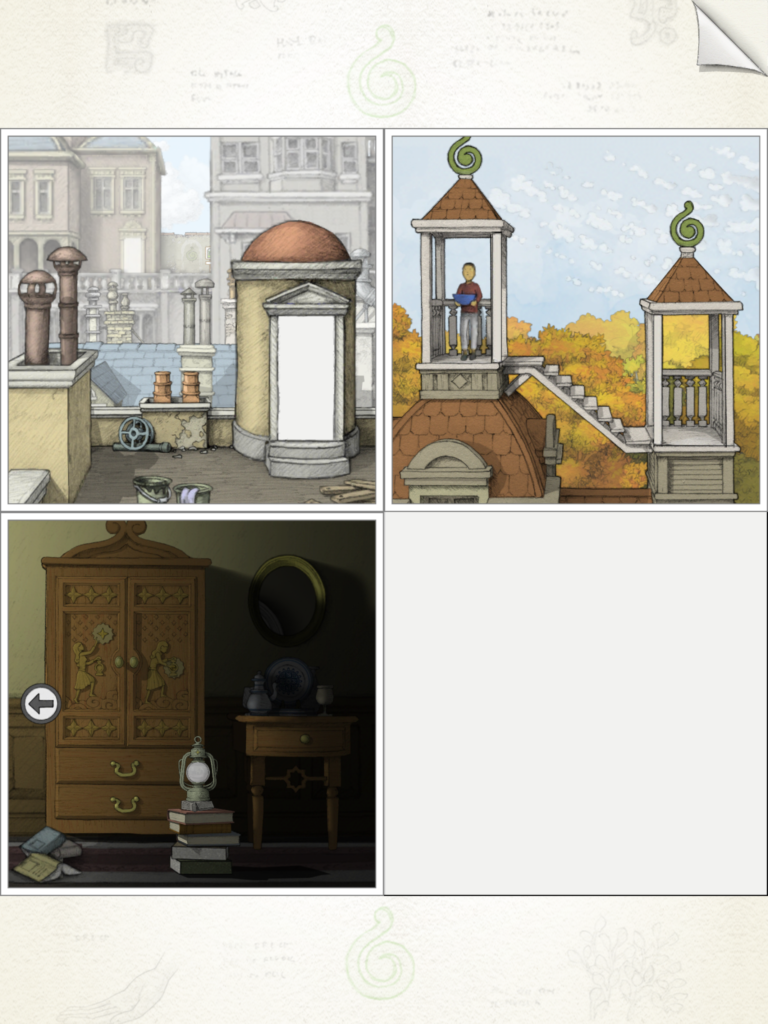 (illustration of lighting up a lamp on bottom-left panel. At this point in the game, the mechanic is still the basic split-frame, make the character move between panels.)
(illustration of lighting up a lamp on bottom-left panel. At this point in the game, the mechanic is still the basic split-frame, make the character move between panels.)
Things you would change to make the game better:
Perhaps I would add a hint system to make the game more accessible, since some of the puzzles are quite difficult.


